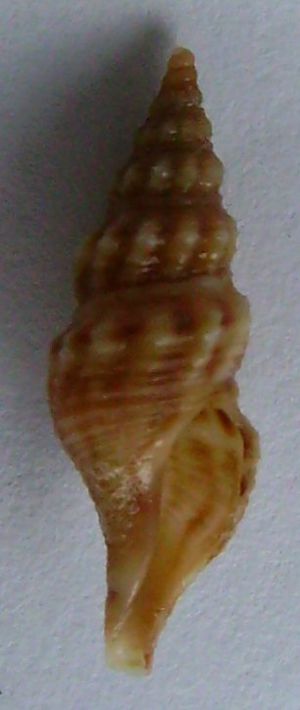Antimelatoma facts for kids
Quick facts for kids Antimelatoma |
|
|---|---|
 |
|
| A shell of Antimelatoma buchanani maorum | |
| Scientific classification |
|
| Kingdom: | Animalia |
| Phylum: | Mollusca |
| Class: | Gastropoda |
| Subclass: | Caenogastropoda |
| Order: | Neogastropoda |
| Superfamily: | Conoidea |
| Family: | Pseudomelatomidae |
| Genus: | Antimelatoma Powell, 1942 |
| Type species | |
| Drillia maorum E.A. Smith, 1877
|
|
| Species | |
|
See text |
|
Antimelatoma is a group of fascinating sea snails. These snails are a type of mollusc, which is a large group of animals that includes clams, oysters, and even octopuses. Antimelatoma snails live in the ocean and are known for being predatory, meaning they hunt and eat other smaller creatures. They belong to a larger family of snails called Pseudomelatomidae, often known as "turrids."
Contents
Discovering Antimelatoma Snails
Antimelatoma is a genus of snails, which is like a specific group within a larger family. These snails were first officially described in 1942 by a scientist named Arthur William Baden Powell. Scientists study these snails to understand more about ocean life and how different species interact.
What Are Sea Snails?
Sea snails are a type of gastropod, which is a class of animals within the phylum Mollusca. This means they are related to slugs, conchs, and even nudibranchs. Most gastropods have a single, spiral shell, which they carry on their back. They move around using a muscular "foot."
Where Do They Live?
Antimelatoma snails are marine animals, meaning they live in the ocean. They are found in the waters around New Zealand. Like many sea snails, they live on the seabed, exploring for food. Their shells help protect them from predators and the ocean environment.
Different Kinds of Antimelatoma
Within the Antimelatoma genus, scientists have identified different species. Each species has its own unique features, even if they look similar to the untrained eye.
Here are some of the known species:
- Antimelatoma buchanani (first described by Hutton in 1873)
- † Antimelatoma waimea (described by Beu in 2011). The dagger symbol (†) means this species is now extinct.

